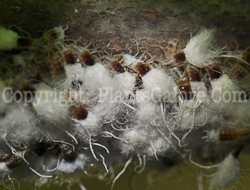|
 |
|
 |
|
 |
 |
 As
the name implies, these are insects that cover
themselves with a waxy, "wooly" covering to protect
themselves during a part of their life cycle. As
aphids, of course,
they are sucking insects that draw sap from the plant
for their nourishment. There are many species of wooly
aphids that are pests of a large number of trees
including
silver maple,
ash,
alder,
apple,
pear,
hawthorn and
serviceberry. As
the name implies, these are insects that cover
themselves with a waxy, "wooly" covering to protect
themselves during a part of their life cycle. As
aphids, of course,
they are sucking insects that draw sap from the plant
for their nourishment. There are many species of wooly
aphids that are pests of a large number of trees
including
silver maple,
ash,
alder,
apple,
pear,
hawthorn and
serviceberry.
Most wooly aphid species
spend their time on alternate hosts. They may lay their
eggs on a host plant where they can overwinter. In the
spring, the female aphids, after a generation or two
develop on the first host, can then fly to the secondary
host species, lay eggs and start things all over again.
Like many aphid species, wooly aphid females can produce
eggs without mating with a male. The offspring are
considered clones of the one parent since they are not
the result of the combination of two sets of genetic
materials.
|
 |
|
 |
 |
The most common sign
is, of course, the presence of the insect itself. In
severe infestations, there is a mass of white,
woolly filaments extending from the branch or twig.
These growths are primarily there as a deterrent to
insect predators.
Another sign that is
common to most aphid infestations is the presence of
a black, powdery covering on leaves beneath where
the insects are feeding. This is
sooty
mold, a fungus that grows on the sugar rich
droppings of the insects.
The key symptom for
some of the aphids is the presence of distorted,
twisted leaves. When they feed on the leaves and
remove water and sap, the leaves will crumple and
become misshappened.
|
 |
 |
 |
The primary damage
done by wooly aphids is the removal of sugars and
carbohydrates from the plants through their feeding.
In very large, long-lasting infestations, this can
weaken twigs and, sometimes, branches of the plants.
In combination with other stresses such as droughts,
this may result in the death of certain plant parts.
|
 |
 |
 |
Since these insects are
rather sedentary, it is relatively easy to see when they
have built up to large numbers. They do not fly or run
away and hide. So, treatment can be rather
straightforward once you determine that your threshold
has been reached.
Insecticidal soaps may be effective when sprayed onto
the aphids. Soaps tend to melt the waxy coating on the
skin of insects causing them to dry out and die.
Other standard
insecticides are also labeled for use
with wooly aphids.
|
|
 |
|
Note: We
have provided some general information and
observations on this topic aimed at the home
gardener. Before you take
any serious action in your landscape, check
with your state's land grant university's
Cooperative
Extension
Service for the most current,
appropriate, localized recommendations. |
|
 |
|



